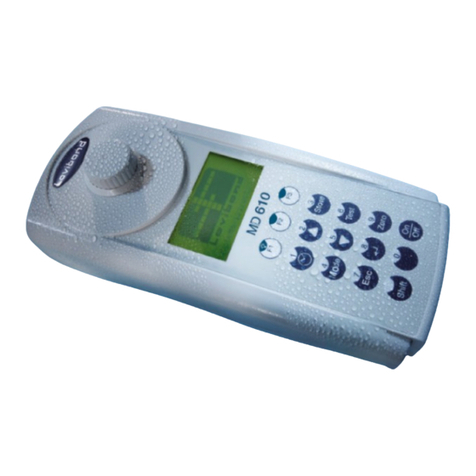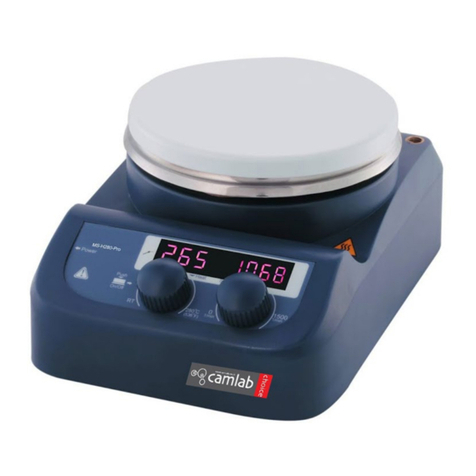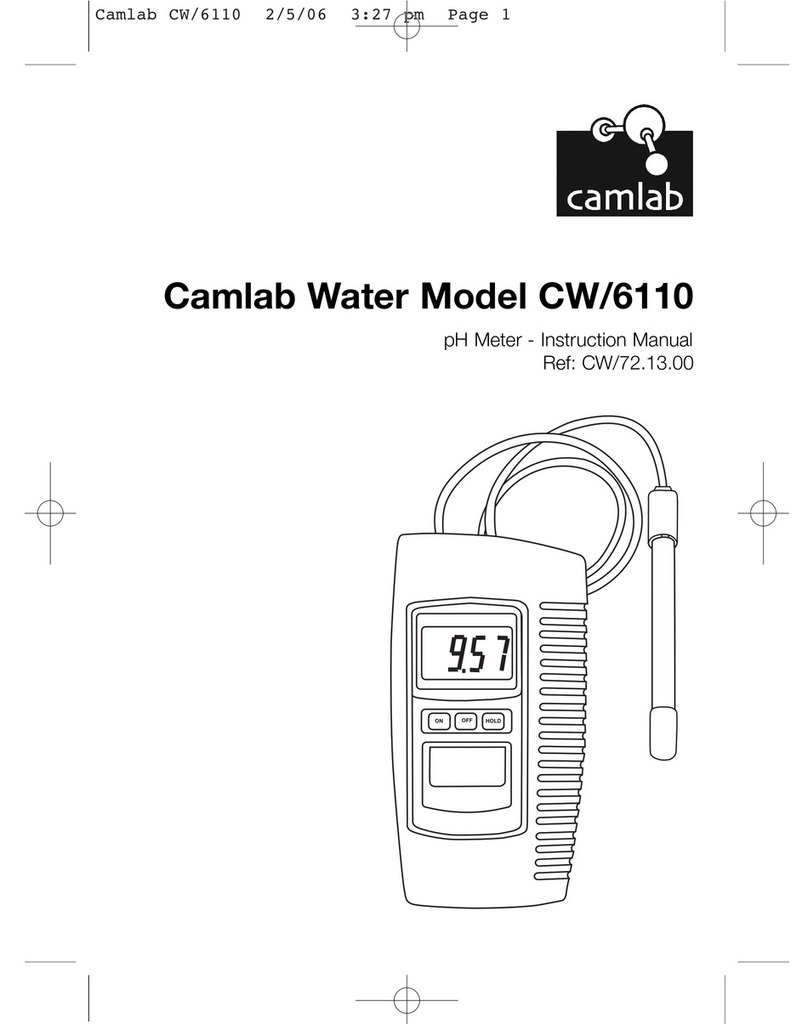
Optics: LED:λ= 528 nm
Battery: 9 V block battery (life = approx. 600 tests)
Auto-OFF: auto unit switch-off approx. 5 minutes after a
key was last pressed
Ambient conditions
:
5-40°C
30-90% rel. humidity (non-condensing)
CE:
DIN EN 55 022, 61 000-4-2, 61 000-4-8,
50 082-2, 50 081-1, DIN V ENV 50 140, 50 204
Technical data
Operation
CW2050 Colorimeter for Chloride
User messages
Zero
Test
METHOD
METHOD
METHOD
METHOD
0.0.0
RESULT
RESULT
Zero
Test
÷Err
EOI
-Err
LO BAT
ON
OFF
r1
Chloride 0,5 - 25 mg/l
0.0.0
RESULT
RESULT
Zero
Test
r1
Switch the unit on using the ON/OFF switch
The display shows the following:
Select analysis using the MODE key:
r1 →r2 →r1 .......... (Scroll)
The display shows the following:
Pour 1 ml of the water sample into a clean vial and fill to
the 10 ml mark with deionized water. Replace the cap
tightly and place the vial in the sample chamber with the
∇vial marking aligned with the∆housing marking.
Press the ZERO/TEST key.
The method symbol flashes for approx. 3 seconds.
The display shows the following:
After zero calibration is completed, remove the vial from
the sample chamber.
The characteristic coloration starts to appear after the
addition of the reagent tablet(s).
Replace the cap tightly and place the vial in the sample
chamber with the ∇and ∆marks aligned.
Press the ZERO/TEST key.
The method symbol flashes for approx. 3 seconds.
The result appears in the display.
Repeating the analysis:
Press the ZERO/TEST key once again.
New zero calibration:
Press the MODE key until the desired method symbol
appears in the display again.
Light absorption too great. Reason - e.g. soiled lens.
Measuring range exceeded or excessive turbidity.
Result outside bottom measuring range limit.
Replace 9 V battery immediately; no further analysis
possible.
Perform zero calibration (see “Operation”).
Adjust the sample temperature to 20°C ±2 °C.
Add one CHLORIDE T1 tablet straight from the foil to the
prepared vial. Crush using a clean stirring rod and mix
until all particles of the tablet have dissolved. Add one
CHLORIDE T2 tablet straight from the foil to the same
sample, crush and mix gently to dissolve. Ensure all
particles are dissolved – Chloride causes an extremly finely
distributed Turbidity with a milky appearance. Replace
the cap tightly and place this vial in the sample chamber
with the ∇and ∆marks aligned.
Wait for a reaction time of 2 minutes!
(do not remove or shake the vial during this time)
Press the ZERO/TEST key.
The method symbol flashes for approx. 3 seconds.
The result is shown in the display in mg/l Cl
–
.
Tolerance: ±2,5 mg/l.
Chloride 5 - 250 mg/l
The display shows the following:
Pour 1 ml of the water sample into a clean vial and fill to
the 10 ml mark with deionized water. Replace the cap
tightly and place the vial in the sample chamber with∇
and ∆marks aligned.
Press the ZERO/TEST key.
The method symbol flashes for approx. 3 seconds.
The display shows the following:
Adjust the sample temperature to 20°C ±2 °C.
Add one CHLORIDE T1 tablet straight from the foil to the
prepared vial. Crush using a clean stirring rod and mix
until all particles of the tablet have dissolved. Add one
CHLORIDE T2 tablet straight from the foil to the same
sample, crush and mix gently to dissolve. Ensure all
particles are dissolved – Chloride causes an extremly finely
distributed Turbidity with a milky appearance. Replace
the cap tightly and place this vial in the sample chamber
with the ∇and ∆marks aligned.
Wait for a reaction time of 2 minutes!
(do not remove or shake the vial during this time)
Press the ZERO/TEST key.
The method symbol flashes for approx. 3 seconds.
The result is shown in the display in mg/l Cl
–
.
Tolerance: ±25 mg/l.
RESULT
RESULT
Zero
Test
r2
Zero
Test
METHOD
METHOD
0.0.0
r2
METHOD
METHOD
Mode
Troubleshooting: Guidelines for photometric measurements
1. Vials, caps and stirring rods should be cleaned thoroughlyafter each
analysis to prevent errors being carried over. Even minor reagent
residues can cause errors in the test results. Use the brush provided for
cleaning.
2. The outside of the vial must be clean and dry before starting the analysis.
Clean the outside of the vials with a towel. Fingerprints or other marks
will be removed.
3. Zero calibration and test must be carried out with the same vial as there
may be slight differences in optical performance between vials.
4. The vials must be positioned in the sample chamber for zero calibration
and test with the ∆-mark on the vial aligned with the∇−mark on the
instrument.
5. Always perform “Zero calibration” and “Test” with closed vial lid.
6. Bubbles on the inside walls of the vial lead to incorrect measurements.
To prevent this, remove the bubbles by swirling the vial before performing
the test.
7. Avoid spillage of water or reagent solution in the sample chamber. If
water should leak into the photometer housing, it can damage electronic
components and cause corrosion.
8. Soiling of the lens (LED and photosensor) in the sample chamber leads
to incorrect measurements.
Check - and if necessary clean - the light entry surfaces of the sample
chamber at regular intervals. Clean using a moist cloth and cotton buds.
9. Always add the reagent tablets to the water sample straight from the
foil without touching them with your fingers.
10. Large temperature differentials between the photometer and the
operating environment can lead to incorrect measurement due to the
formation of condensate in the area of the lens or on the vial (e.g).
11. To avoid errors caused by stray-light do not use the instrument in bright
sunlight.
Zero
Test
Zero
Test
Zero
Test
Zero
Test
Zero
Test
• Replacement Reagents
Chloride T1 tablet pk 100
Ref: TT/51.59.00
Chloride T2 tablet pk 100
Ref: TT/51.59.20
• Notes
1. High concentrations of electrolytes and organic compounds have different
effects on the precipitation reaction.
2. Ions which also form deposits with silver nitrate in acidic media, such as
bromides, iodides and thiocyanates, interfere with the analysis.
3. Highly alkaline water should - if necessary - be neutralised using nitric acid
before the reaction is performed using the reagent tablet.
• Method notes
Observe application options, analysis regulations and matrix effects of methods.
Reagent tablets are designed for use in chemical analysis only and should be
kept well out of the reach of children.
If necessary, request safety data sheets.
Ensure proper disposal of reagent solutions.
Mode
Camlab CW2050 Chloride 2/5/06 3:21 pm Page 1



























